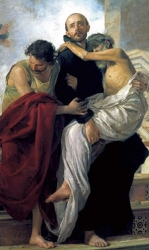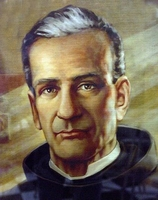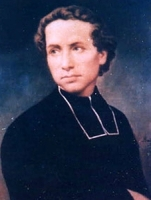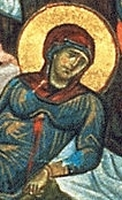Saint Frances of Rome
ரோம் நகர் புனிதர் ஃபிரான்செஸ்
(St. Frances of Rome)
நிறுவனர் (Founder):
பிறப்பு: கி.பி. 1384
ரோம், திருத்தந்தையர் மாநிலங்கள்
(Rome, Papal States)
இறப்பு : மார்ச் 9, 1440
ரோம், திருத்தந்தையர் மாநிலங்கள்
(Rome, Papal States)
ஏற்கும் சமயம்:
ரோமன் கத்தோலிக்க திருச்சபை
(Roman Catholic Church)
புனிதர் பட்டம்: 1608
திருத்தந்தை 5ம் பவுல்
(Pope Paul V)
முக்கிய திருத்தலம்:
புனிதர் ஃபிரான்செஸ் ரோமானா தேவாலயம், ரோம்
(Church of Santa Francesca Romana, Rome, Italy)
நினைவுத் திருநாள்: மார்ச் 9
பாதுகாவல்:
'சத்தியப் பிரமாண உறுதிமொழிகளை எடுத்துக்கொள்ளாத' பெனடிக்டைன் மறைப் பணியாளர் அமைப்பு (Benedictine Oblates)
வாகனம் ஓட்டுநர் (Automobile Drivers)
கைம்பெண்கள் (Widows)
புனிதர் ஃபிரான்செஸ், ஒரு ஆத்ம பலம் கொண்ட இத்தாலிய புனிதர் ஆவார். இவர் ஒரு மனைவியும், தாயும், தொண்டு - சேவை அமைப்புகளின் ஒருங்கிணைப்பாளரும் ஆவார். இவர், "சத்தியப் பிரமாண உறுதிமொழிகளை எடுத்துக்கொள்ளாத' பெனடிக்டைன் மறைப் பணியாளர்" (Benedictine Oblates) அமைப்பினை நிறுவியவரும் ஆவார்.
ரோம் நகரின் ஒரு பிரபுத்துவ செல்வந்தர் குடும்பத்தில் பிறந்த இவரது தந்தை "பவோலா புஸ்ஸா" (Paolo Bussa) ஆவார். இவரது தாயாரின் பெயர், "லகொபெல்லா" (Iacobella dei Roffredeschi) ஆகும். தமது 11 வயதில், இவர் ஒரு அருட்சகோதரியாக துறவறம் பெற விரும்பினார். ஆனால், இவரது பெற்றோர் இவருக்கு திருமண ஏற்பாடுகளைச் செய்தனர்.
ஃபிரான்செஸின் 12 வயதில், மிகவும் செல்வந்தர் குடும்பத்தைச் சேர்ந்தவரும், திருத்தந்தையரின் போர்ப்படையின் ரோம் நகர தளபதியுமான "லோரன்ஸோ போன்ஸியானி" (Lorenzo Ponziani) என்பவருக்கு வற்புறுத்தி திருமணம் செய்து வைத்தனர். இவர்களது திருமண வாழ்க்கை சுமார் நாற்பது வருடங்கள் நீடித்தது. லோரன்ஸோ தமது மனைவியை மிகவும் போற்றியதால் இவர்களது மணவாழ்க்கை மகிழ்ச்சியாக இருந்தது.
லோரன்ஸோ அடிக்கடி போர் நடவடிக்கைகள் காரணமாக வெளியூர்கள் சென்றதால், அவர் அப்படி போகும் காலங்களிலெல்லாம் ஃபிரான்செஸ் தமது கணவரின் சகோதரரின் மனைவியான "வன்னோஸ்ஸா" (Vannozza) என்பவருடன் ஏழைகளுக்கும் நோயுற்றோர்க்கும் சேவை மற்றும் பணிவிடைகள் செய்யச் சென்றார். இருவரது கணவர்மாரின் ஆசீர்வாதங்களுடன் இவர்கள் பணியாற்றினர். நகரின் பிற செல்வந்தர் குடும்பங்களின் பெண்களையும் ஏழை மற்றும் நோயுற்றோரின் சேவை செய்ய ஃபிரான்செஸ் மற்றும் வன்னோஸ்ஸா ஊக்குவித்தனர்.
ஒருமுறை ஃபிரான்செஸ் தீவிர நோய்வாய்ப்பட்டார். அவரது கணவன், மாய வித்தைகள் செய்யும் ஒருவனை அழைத்து வந்தார். ஆனால், ஃபிரான்சஸ் அவனை விரட்டிவிட்டார். பின்னர், புனித அலெக்சிஸ் அவருக்கு தோன்றி அவரை குணப்படுத்தியதாக வன்னோஸ்ஸாவுக்கு நினைவுபடுத்தினார். நோயினால் ஏற்பட்ட வேதனைகளும் துன்பங்களும் எழைகளின்பாலும் நோயுற்றோரின்பாலும் அவரது அர்ப்பணிப்பு மற்றும் பொறுப்பினை மேலும் ஆழப்படுத்தியது.
ஃபிரான்செஸின் மாமியார் மரணமடைந்ததன் பின்னர், வீட்டின் முழு பொறுப்பும் இவரிடம் வந்தது. ஒருமுறை வெள்ளமும் பஞ்சமும் வந்த காலத்தில், தமது குடும்ப சொத்தான பண்ணை தோட்டத்தின் ஒரு பகுதியை மருத்துவமனையாக மாற்றினார். ஏழை மக்களுக்கு உணவுப் பொருட்களும் ஆடைகளும் வழங்கினார். இவரது நடவடிக்கைகளால் கோபமுற்ற இவரது மாமனார், ஒருமுறை உணவுப்பொருட்கள் சேமித்து வைத்திருக்கும் பண்டகசாலைகளின் சாவிகளை எடுத்துக்கொண்டு சென்றார். ஆனால், ஃபிரான்செஸ் தமது வழக்கமான செபத்தை முடித்ததும் சோள மூட்டைகளும் திராட்சை இரச பீப்பைகளும் அதிசயிக்கும் விதமாக நிரம்பியதைக் கண்டு, எடுத்துச் சென்ற சாவிகளை திரும்ப கொடுத்தார்.
வருடங்கள் செல்ல, ஃபிரான்செஸ் இரண்டு ஆண் குழந்தைகளையும் ஒரு பெண் குழந்தையையும் ஈன்றார். குழந்தைகள் பிறக்க, அவரது குடும்பப் பொறுப்பும் அதிகரித்தது. குடும்பத்தின்மேல் அதிக அக்கறை காட்ட தொடங்கினார். ஃபிரான்செஸின் அக்கறை மற்றும் கவனிப்பினால் அவரது குடும்பம் தழைத்தோங்கி செழித்தது.
ஆனால் சில வருடங்களில், இத்தாலி நாடு முழுதும் பரவிய பிளேக் நோய், கோர தாண்டவமாடியது. ரோம் நகரம் முழுதும் பேரழிவு கொடுமை ஏற்பட்டது. அதன் காரணமாக, ஃபிரான்செஸின் இரண்டாவது மகன் மரித்துப் போனான். பிளேக்கினால் பாதிக்கப்பட்டோரின் துயரங்களைப் போக்கும் முயற்சியாக, ஃபிரான்செஸ் தமது பணம் முழுவதையும் உபயோகித்தார். நோயுற்றோரின் அத்தியாவசிய தேவைகளை வாங்கும் பொருட்டு, தமது சொத்து முழுவதையும் விற்றார்.
அனைத்து வளங்களும் சொத்துக்களும் தீர்ந்து போயின. ஃபிரான்செஸும் வன்னோஸ்ஸாவும் வீடு வீடாக ஏறி இறங்கி, நோயுற்றோரின் தேவைகளுக்காக பிச்சை எடுத்தனர். பின்னர், ஃபிரான்செஸின் மகளும் மரித்துப் போனார். இப்புனிதர் தமது வீட்டின் ஒரு பகுதியை மருத்துவமனையாக மாற்றினார்.
இத்தகைய வாழ்க்கைமுறை உலகிற்கு மிகவும் அவசியமானதென்று ஃபிரான்செஸ் மென்மேலும் நம்பிக்கையும் உறுதியும் கொண்டார். 1425ம் ஆண்டு, ஆகஸ்ட் மாதம், 15ம் நாள், அன்னை மரியாளின் விண்ணேற்பு திருவிழாவன்று, "சத்தியப் பிரமாணம் எடுத்துக்கொள்ளாத' மரியாளின் ஒலிவேட்டன் மறைப் பணியாளர்" (Olivetan Oblates of Mary) எனும் அமைப்பினை நிறுவினார். எவ்வித துறவற பிரமாணங்களுக்கும், உறுதிமொழிகளுக்கும் கட்டுப்படாத பெண்களின் சமூகம் உதித்தது. இப்பெண்கள் தம்மை இறைவனுக்கும், ஏழைகளின் சேவையிலுமே அர்ப்பணித்தனர். 1433ம் ஆண்டு, மார்ச் மாதம், “கோம்பிடோக்லியோ” (Campidoglio) எனும் இடத்திற்கு அருகிலுள்ள “டோர் டி ஸ்பெச்சி” (Tor de' Specchi) எனுமிடத்தில், துறவு மதத்தினை நிறுவினார். அதே ஜூலை மாதம் நான்காம் தேதி, இதற்கு திருத்தந்தை “நான்காம் யூஜின்” (Pope Eugene IV) அவர்களின் அங்கீகாரம் கிட்டியது.
"பெனடிக்டைன் மறைப் பணியாளர்" அமைப்பு நிறுவப்பட்டதும் ஃபிரான்செஸ் அச்சமூகத்தினருடன் தங்கவில்லை. மாறாக தமது கணவருடன் தமது வீட்டிலேயே வாழ்ந்தார். சுமார் ஏழு வருடங்கள் இங்ஙனம் வாழ்ந்த ஃபிரான்செஸ், 1436ம் ஆண்டு, தமது கணவரின் மரணத்தின் பின்னர், அவரது சமூகத்தினருடன் தங்கி வாழ்ந்தார். ஏழைகளின் ஏழையாக பணியாற்றினார்.
புனிதர் அன்னை தெரசா, செபித்தல் மூலமாக இறைவனை அன்பு செய்வது மட்டுமல்லாது, ஏழைகளுக்கு சேவை செய்வதன் மூலமும் இறைவனை அன்பு செய்யலாம் என்பதற்கு எடுத்துக்காட்டாக விளங்கினார். அவ்வாறே, சேவை செய்வதன் மூலம் இறைவனை அன்பு செய்ய, மத பிரமாணங்களும், உறுதிமொழிகளும் எடுத்துக்கொண்ட துறவிகளாக மட்டுமே இருக்கவேண்டும் என்ற அவசியமில்லை என்பதனை புனிதர் ஃபிரான்செஸ் நிரூபித்துள்ளார்.
Also known as
• Franziske av Rome
• Francesca Bussa de' Leoni
• Francesca Romana
Profile
Born to the aristocracy, the daughter of Paul Bussa and Jacobella de' Roffredeschi. Married at age twelve to Lorenzo de' Ponziani; her marriage lasted 40 years. Mother of three in 1400, 1404, and 1407. Widow.
Benedictine. Foundress of the Oblates of the Tor de' Specchi (Collatines). Said to have been guided by an archangel only she could see. Spent her life and fortune, both as laywoman and religious, in the service of the sick and the poor, including the founding of the first home in Rome for abandoned children. Dictated 97 Visions, in which she saw many of the pains of Hell.
On her feast day priests bless cars due to her patronage of cars and drivers. Frances certainly never drove, but legend says that when she went abroad at night, her guardian angel went before her, lighting the road with a headlight-like lantern, keeping her safe in her travels.
Born
1384 in Rome, Italy as Francesca Bussa de' Leoni
Died
• 1440 in Rome, Italy
• relics at Saint Frances of Rome Church, Rome, Italy
• entombed beneath the pavement of the Ponziani sacristy of the Church of Saint Cecilia, Rome, Italy
Canonized
29 May 1608 by Pope Paul V
Patronage
• against plague
• automobile drivers (given in 1951)
• automobilists
• aviators
• cab drivers
• death of children
• lay people
• motorcyclists
• motorists
• people ridiculed for their piety
• pilots
• Roman housewives
• taxi drivers
• widows
• women
• Rome, Italy
Saint Catherine of Bologna
போலோக்னா நகர் புனிதர் கேதரின்
(St. Catherine of Bologna)
மறைப்பணியாளர்/ அருட்கன்னியர்:
(Religious/ Virgin)
பிறப்பு: செப்டம்பர் 8, 1413
போலோக்னா, இத்தாலி
(Bologna, Italy)
இறப்பு: மார்ச் 9, 1463 (வயது 49)
போலோக்னா, இத்தாலி
(Bologna, Italy)
ஏற்கும் சமயம்:
ரோமன் கத்தோலிக்க திருச்சபை
(Roman Catholic Church)
முக்திபேறு பட்டம்: 1524
திருத்தந்தை ஏழாம் கிளமென்ட்
(Pope Clement VII)
புனிதர் பட்டம்: மே 22, 1712
திருத்தந்தை பதினொன்றாம் கிளமென்ட்
(Pope Clement XI)
நினைவுத் திருவிழா: மார்ச் 9
பாதுகாவல்:
போலோக்னா (Bologna), சோதனைகளுக்கு எதிராக, கலைஞர்கள், உதாரண கலைகள்
புனிதர் கேதரின், இத்தாலி நாட்டின் “எளிய கிளாரா” சபையைச் சேர்ந்த அருட்கன்னியரும் (Italian Poor Clare nun), எழுத்தாளரும், ஆசிரியையும், கலைஞரும், ஆத்ம பலம் கொண்ட உள்ளுணர்வாளரும், புனிதருமாவார்.
வடக்கு இத்தாலியின் (Northern Italy) “எமிலியா ரோமாக்னா” (Emilia-Romagna Region) மாகாணத்தின் தலைநகரும், பெரிய நகருமான போலோக்னா’வின் (Bologna) உயர்மட்ட குடும்பமொன்றினைச் சேர்ந்த கேதரினுடைய தந்தை, “பென்வெனுட்டா மம்மொலினி” (Benvenuta Mammolini) ஆவார். இவர், பத்திரங்களுக்குச் சட்டபூர்வ அங்கீகாரமளிக்கும் சான்று அலுவலர் (Notary) ஆவார். இவர், ஃபெர்ராரா மற்றும் மொடேனா”’ ஆகிய பெரு நிலங்களின் பிரபுவான (Duke of Ferrara and of Modena) “மூன்றாம் நிக்கோலோ டி எஸ்ட்” (Niccolò III d'Este) என்பவருடைய அரசவையில் பணியாற்றியவருமாவார். கேத்தரினின் தாயார் “ஜியோவன்னி விக்ரி” (Giovanni Vigri) ஆவார். மூன்றாம் நிக்கொலோவின் அரண்மனையில் வளர்ந்த கேதரின், நிக்கொலோவின் மகளான “மார்கரிட்டாவின்” (Margherita) வாழ்நாள் சிநேகிதியானார். இக்காலகட்டத்தில், அங்கே எழுதவும் படிக்கவும் கற்றுக்கொண்ட இவர், வரைதல், சங்கீதம், பாடுதல் மற்றும் சாத்தியமான வெளிச்சம் ஆகியவற்றை கற்றார்.
கி.பி. 1426ம் ஆண்டு, மூன்றாம் நிக்கொலோவின் அரண்மனையை விட்டு வெளியேறிய கேதரின், உறுதிமொழி பிரமாணங்கள் எடுத்துக்கொள்ளாத, அகுஸ்தீனிய விதிகளை (Augustinian Rule) பின்பற்றும் ஒரு ஆன்மீக சமூகத்தில் இணைந்தார். கி.பி. 1431ம் வருடம், இச்சமூகத்தின் இல்லம், “கார்பஸ் டோமினியின் எளிய கிளாரா கான்வன்ட்” (Poor Clare convent of Corpus Domini) விதிமுறைகளை பின்பற்றும் அமைப்பாக மறு-சீரமைக்கப்பட்டது. 12 பெண்களுடன் தொடங்கப்பட்ட இவ்வமைப்பானது, நூற்றாண்டின் இறுதியில் 144 பெண்களின் அமைப்பாக வளர்ந்தது.
ஃபெர்ராராவிலுள்ள (Ferrara) “கார்பஸ் டோமினி” (Corpus Domini) இல்லத்திலேயே தங்கியிருந்த கேதரின், புதுமுக பயிற்சி துறவியரின் (Mistress of Novices) தலைவராகவும் இருந்தார். யாருமில்லாமலேயே ரொட்டி சுடப்படும் அற்புதத்தை அனுபவித்த கேதரின், பலமுறை கிறிஸ்து இயேசு, அன்னை மரியாள் மற்றும் தூய சூசையப்பர் ஆகியோரின் அற்புத தரிசனம் கிட்டும் பாக்கியம் பெற்றார். நடக்க இருக்கும் முக்கிய சம்பவங்களை முன்னறிவிக்கும் அற்புத சக்தியும் பெற்றிருந்தார். கி.பி. 1453ம் ஆண்டு, “கான்ஸ்டண்டிநோபில்” (Fall of Constantinople) வீழ்ச்சி, இவர் முன்னறிவித்ததேயாம்.
கி.பி. 1456ம் ஆண்டு, ஃபிரான்சிஸ்கன் துறவியரும், போலோக்னா ஆளுநர்களும், போலோக்னாவில் “கார்பஸ் டோமினி” (Corpus Domini) எனும் பெயரில் புதிதாய் நிறுவப்படும் கான்வென்ட் பள்ளிக்கு தலைமைப் பொறுப்பேற்க வருமாறு கேதரினை அழைத்தனர். பன்னிரெண்டு பெண் துறவியருடன் ஃபெர்ராராவை (Ferrara) விட்டு கிளம்பிய கேதரின், தமது மரணம் வரை அங்கேயே இருந்தார். கி.பி. 1463ம் ஆண்டு, மார்ச் மாதம், ஒன்பதாம் நாளன்று அவர் மரித்தபோது, அவர் பள்ளியின் கல்லறைத் தோட்டத்தில் அடக்கம் செய்யப்பட்டார். பதினெட்டு நாட்கள் கழித்து, ஒரு இனிமையான நறுமணம் கல்லறையில் இருந்து வெளிப்பட்டது. அவரது உடல் தோண்டி எடுக்கப்பட்டபோது, அது கெட்டுப்போகாமல் இருந்தது. போலோக்னாவில் உள்ள எளிய கிளாராக்களின் (Chapel of the Poor Clares in Bologna) சிற்றாலயத்தில் மறு அடக்கம் செய்யப்பட்டது.
புனிதர் கேதரின் எழுதிய “ஆன்மீக யுத்தத்துக்கு அவசியமான ஏழு ஆன்மீக ஆயுதங்கள்” (Seven Spiritual Weapons Necessary for Spiritual Warfare) உள்ளிட்ட அநேகம் ஆன்மீக இலக்கியங்கள் இன்றளவும் நடைமுறையில் உள்ளன. இவர் எழுதிய 2000க்கும் மேற்பட்ட, பல புதிய இலக்கிய படைப்புகள் சமீப காலங்களில் கண்டுபிடிக்கப்பட்டு, இத்தாலிய மொழியில் அச்சிடப்பட்டு போலாக்னாவில் வெளியிடப்பட்டுள்ளன.
Also known as
• Caterina dei Vigri
• Caterina Vigri
• Catherine da Bonon
Profile
Born to the nobility of Bologna, Italy, the daughter of a diplomat. Tradition says her father received a vision telling him of her birth. Maid of honour to the daughter of a marquis, receiving the same training and education as her mistress. Franciscan tertiary at age 14. Poor Clare nun. Novice mistress. Established a Poor Clare convent at Bologna, Italy in 1456, and served as its abbess. Miracle worker. Prophetess. Mystic. Visionary. Painter and manuscript illuminator. Received a Christmas Day vision of Jesus cradled in Mary's arms.
Born
8 September 1413 at Bologna, Italy as Caterina dei Vigri
Died
• 9 March 1463 at Bologna, Italy of natural causes
• buried without a coffin or embalming
• exhumed eighteen days later due to the miracles occurring near her grave, and the odor of perfume that came from it
• body found incorrupt
• currently resides in the cell in which she lived
Canonized
22 May 1712 by Pope Clement XI
Patronage
• against temptations
• art
• artists
• Bologna Academy of Art
• liberal arts
• painters
Saint Gregory of Nyssa
Profile
Younger brother of Saint Basil the Great. Friend of Saint Gregory of Nanzienzen. Educated in Athens, Greece. Influenced by the works of Origen and Plato. Married to Theosebeia, who may have been a deaconess. Professor of rhetoric.
Disillusioned with his life as a teacher, he became a priest and hermit; his mother and sister already lived the monastic life. Bishop of Nyssa, Lower Armenia, in 372. Archbishop of Sebaste. Fought against Arianism, but not as successfully as he hoped.
Easy-going, tactless, inefficient in monetary matters, Gregory was cheated and deceived to the point that Demosthenes, governor of Pontus, accused him of stealing Church property and had him imprisoned. He escaped, but was deposed by a synod of bishops in 376. He wandered in exile for two years, then was restored to his see.
Attended the Council of Antioch. Fought the Meletian heresy. Participated in the second ecumenical Council at Constantinople as a theologian. Fought Arianism and reaffirmed the decrees of the Council of Nicaea. The council called him, "Father of the Fathers" because he was widely venerated as the great pillar of orthodoxy and the great opponent of Arianism. Father of the Church.
There is some debate about Gregory's relationship with his wife following his episcopal consecration. Some say he continued to live with her, but Saint Jerome says that the eastern churches did not permit this.
Born
c.333 at Caesarea, Cappadocia
Died
c.398 of natural causes
Saint Dominic Savio
புனித தோமினிக் சாவியோ (இத்தாலியம்: Domenico Savio; ஏப்ரல் 2, 1842 – மார்ச் 9, 1857[5][6]), இத்தாலியைச் சார்ந்த புனித ஜான் போஸ்கோவின் வளரிளம் பருவ மாணவர்களில் ஒருவர். இவர் குருவாகும் ஆசையில் படித்துக் கொண்டிருந்தபோது தனது 14ஆம் வயதில் நோயுற்று இறந்தார்.[7]
பதினான்கு வயதே நிரம்பிய தோமினிக் சாவியோவின், வீரத்துவம் நிறைந்த அன்றாடப் புண்ணிய வாழ்வே இவரைப் புனிதர் நிலைக்கு உயர்த்தியது.[8] கத்தோலிக்க திருச்சபையில் மறைசாட்சியாக இறக்காத புனிதர்களில் இவரே மிகவும் இளையவர்.[9]
வீட்டு வாழ்வு
தோமினிக் சாவியோ, 1842 ஏப்ரல் 2ந்தேதி இத்தாலியில் உள்ள ரிவா ப்ரெஸோ சியரியில் பிறந்தார். இவர் சிறுவயதில் இருந்தே இயேசுவிடமும் அன்னை மரியாவிடமும் மிகுந்த பக்தி கொண்டிருந்தார். இவரது குடும்பமும் சூழ்நிலையும் இவரை புனிதத்தில் வளர்த்தன. இவரது பெற்றோர் இவரை கிறிஸ்தவ மதிப்பீடுகளில் வளர்ப்பதில் அதிக ஆர்வம் காட்டினர்.[10] நான்கு வயதிலேயே இவர் தனியாக செபிக்கும் திறமை பெற்றிருந்தார்.[11]
சாவியோ தான் முதல் நற்கருணை பெற்ற நாளைப் பற்றிக் குறிப்பிடும்போது, "என் வாழ்வின் மிகவும் மகிழ்ச்சியானதும் அற்புதமானதுமான நாள் அது" என்கிறார்.[12] இவர் ஆலயத்தின் பீடச் சிறுவர்கள் குழுவில் இணைந்து திருப்பலியில் குருக்களுக்கு உதவி செய்தார்; அதிகாலை 5 மணிக்கே ஆலயம் சென்றுவிடும் வழக்கத்தைக் கொண்டிருந்தார். மழையிலும், குளிரிலும் இவர் ஆலயத்திற்கு தவறாமல் சென்றார்.
ஆரட்டரியில்
12 வயதில் கடவுளின் அழைப்பை உணர்ந்து, புனித ஜான் போஸ்கோ நடத்திய ஆரட்டரியில் சாவியோ சேர்ந்தார். 1854 அக்டோபர் முதல் திங்கள் கிழமை தனது தந்தையுடன் புனித ஜான் போஸ்கோவை சந்தித்த இவர்,[13] “நான் தைக்கப்படாத துணியாக இருக்கிறேன், என்னை இயேசுவுக்கு உகந்த நல்ல சட்டையாகத் தைப்பது உங்கள் பணி” என்று அவரிடம் கூறினார்.
கெட்ட வார்த்தைகள் பேசிய சிறுவர்களை சாவியோ கண்டித்து திருத்தினார்; சண்டையிட்டுக் கொண்ட சிறார்களுக்கிடையே சமாதானம் செய்துவைத்தார். தீய வழிகளில் இருந்து விலகி, களங்கமற்ற தூய்மையான புண்ணிய வாழ்வு வாழ்ந்தார். தனது செயல்கள் அனைத்தையும் இறைவனின் புகழ்ச்சிக்காகவே செய்து வந்தார்.
குருத்துவ படிப்பு
இறுதியில் சாவியோ குரு மடத்தில் சேர்ந்தார். ‘பாவம் செய்வதை விட சாவதே மேல்’ என்பது இவரது விருதுவாக்கு ஆகும். 14ஆம் வயதில் இவருக்கு உடல் நலம் பாதிக்கப்பட்டதால் மிகவும் பலவீனம் அடைந்தார். 1857 மார்ச் 9ந்தேதி விண்ணகக் காட்சியால் பரவசம் அடைந்து, “ஆகா, எவ்வளவு இன்பம் நிறைந்த அற்புத காட்சி!” என்று கூறியவாறே தோமினிக் சாவியோ உயிர் துறந்தார்.
தோமினிக் சாவியோ இறந்ததும் புனித ஜான் போஸ்கோ இவரது வாழ்க்கை வரலாற்றை புத்தகமாக எழுதினார்.[4] அது இவரது புனிதர் பட்டமளிப்பு நடவடிக்கைகளில் முக்கிய ஆதாரமாக விளங்கியது.
புனிதர் பட்டம்
சாவியோவின் புனிதர் பட்டத்திற்கான நடவடிக்கைகளைத் தொடங்கிவைத்த திருத்தந்தை 10ம் பயஸ்,[14] “தோமினிக் என்னும் இளைஞர், திருமுழுக்கில் பெற்ற புனிதத்தைப் பழுதின்றி காப்பாற்றிக் கொண்டவர்" என்று இவரைப் புகழ்கின்றார்.
1933ல் இவருக்கு வணக்கத்திற்குரியவர் பட்டம் வழங்கிய திருத்தந்தை 11ம் பயஸ், “தூய்மை, பக்தி, ஆன்மீகத் தாகம் ஆகியவற்றின் ஆற்றலால் சாவியோவின் கிறிஸ்தவ வாழ்வு நமக்கு முன்மாதிரியாக உள்ளது” என்று கூறுகிறார்.
திருத்தந்தை 12ம் பயஸ், தோமினிக் சாவியோவுக்கு 1950 மார்ச் 5ந்தேதி அருளாளர் பட்டமும், 1954 ஜூன் 12ந்தேதி புனிதர் பட்டமும்[15] வழங்கி உரை நிகழ்த்திய போது, “இளைஞர்கள் சாவியோவின் வழிகளைப் பின்பற்ற வேண்டும். தீய சக்திகளின் தாக்கங்களைப் புறக்கணித்து, தூய்மையில் நிலைத்து நின்ற சாவியோவின் புனித வாழ்க்கை இளைஞர்களுக்கு சிறந்த எடுத்துக்காட்டு” என்று கூறினார்.
Profile
One of ten children of a blacksmith and seamstress. Protege of Saint John Bosco. Altar boy at age 5. At 12 he entered the Oratory School preparatory to becoming a priest. Well-liked and pious, his health forced him to give up his dream of the priesthood. He died at age 15; his dying words: "What beautiful things I see!"
His birthplace is now a retreat house for teenagers; the home where he grew up in Morialdo is now a retreat house for children. The final house in which he lived is the home in Mondonio where the Savio family moved when he was 10, and where he eventually died. Here you can see his father's metal shop, and his mother's tailoring shop. His tomb is in the basilica of Mary, Help of Christians in Turin, not far from the tomb of his mentor, teacher and biographer, Saint John Bosco.
Born
2 April 1842 at Riva di Chieri, Turin, Italy
Died
9 March 1857 at Mondonio, Italy of natural causes
Canonized
12 June 1954 by Venerable Pope Pius XII
Patronage
• boys
• children's choirs
• choir boys (given on 8 June 1956 by Pope Pius XII)
• choirs
• falsely accused people
• juvenile delinquents
• Pueri Cantors
Saint Bruno of Querfort
Also known as
• Boniface
• Brun
• Apostle of Livonia
• Second Apostle of the Prussians
Additional Memorial
19 June as Boniface of Querfort
Profile
Great-uncle of Saint Bruno of Wurzburg. In 996 he accompanied Emperor Otto III to Rome, Italy where he met Saint Adalbert of Prague. Spiritual student of Saint Romuald and Saint Adalbert of Magdeburg. Wrote a biography of Saint Adalbert, and of the martyred monks known as The Five Polish Brothers. Head of the School of Magdeburg. Chaplain of Emperor Otto III. Benedictine Camaldolese monk, taking the name Boniface in 997. Archbishop to the Slavs in Merseburg (in modern Germany) in 1004. Evangelized Hungarians, Petsbenges, Prussians and Russians. Martyr. He is listed with two feast days because he was known in some areas by his given name (Bruno), and in some by his cloistered name (Boniface).
Born
c.970 at Querfort (in modern Germany) as Bruno
Died
• beheaded by pagan Prussians in 1009
• relics in Poland
Patronage
Prussia
Saint Vitalis of Calabria
Also known as
• Vitalis of Castronuovo
• Vitalis of Castronovo
• Vitale of...
Profile
Monk at the monastery of Saint Philip at Agira, Sicily. Pilgrim to Rome, Italy. Hermit in the Calabria region of Italy for two years before returning to monastic life near Agira for a quiet 12 years. He returned to Calabria to escape the Muslim invasions of Sicily. He later lived at the monastery of Saint Elias in Carbone, Italy, and then as a cave hermit near Armento, Italy where his reputation attracted so many would-be students that he founded a monastery for them. Later founded another monastery in Basilicata. Captured and abused by Muslim raiders, but eventually released. Founded a monastery on Mount Vulture near Rapolla, Italy where he finally retired.
Born
Castronovo di Sicilia, Palermo, Sicily
Died
893 at the monastery on Mount Vulture near Rapolla, Italy of natural causes
Patronage
Castronovo di Sicilia, Sicily
Saint Pacian of Barcelona
Also known as
Pacià, Pacianus
Profile
Married and a father; his son Dexter was high chamberlain to Emperor Theodosius. Bishop of Barcelona, Spain. Wrote on ecclesiastical discipline. Saint Jerome wrote about him, praising his eloquence, learning, chastity, and holiness of life. Pacian wrote, "My name is Christian, my surname is Catholic."
Died
• c.390 at Barcelona, Spain of natural causes
• relics in the altar in church of Santos Justo y Pastor in Barcelona, Spain
Saint Ioannes Baptista Chon Chang-un
Also known as
• Jeon Jang-Un
• Yohan
• John Baptist Chon Chang-un
Additional Memorial
20 September as one of the Martyrs of Korea
Profile
Married layman, father and family man in the apostolic vicariate of Korea. Adult convert. Worked with Saint Petrus Ch'oe Hyong to publish Christian books in Korean, and was imprisoned, tortured and executed with him. Martyr.
Born
1811 in Seoul, South Korea
Died
9 March 1866 in In-Ko-Ri, Seoul, South Korea
Canonized
6 May 1984 by Pope John Paul II
Saint Petrus Ch'oe Hyong
Also known as
• Choe Hyeong
• Peteuro
• Peter Ch'oe Hyong
Additional Memorial
20 September as one of the Martyrs of Korea
Profile
Married layman, father and family man in the apostolic vicariate of Korea. Adult convert. Catechist. Worked with Saint Ioannes Baptista Chon Chang-un to publish Christian books in Korean, and was imprisoned, tortured and executed with him. Martyr.
Born
1814 in Gongju, Chungcheong-do, South Korea
Died
9 March 1866 in In-Ko-Ri, Seoul, South Korea
Canonized
6 May 1984 by Pope John Paul II
Saint Bosa of York
Also known as
Boso
Profile
Benedictine monk at Whitby, England, under Saint Hilda of Whitby. Bishop of Deira (modern York), the southern half of Northumbria, now Yorkshire, in 678. Appointed to the see by Saint Theodore of Canterbury when Saint Wilfrid of York was driven out by King Egfrid. Bishop again in 691 when Wilfrid was exiled after a quarrel with King Aldfrid. Saint Bede says Bosa was "a man beloved by God…of most unusual merit and sanctity." Teacher of Saint Acca.
Died
696 of natural causes
Saint Constantine of Cornwall
Profile
Born a Cornish prince, the son of King Paternus. After a life of vice, Constantine had a conversion experience, repented his sins, and studied the faith in Wales and Ireland. Missionary to the Scottish Picts. Worked with Saint Columbanus. Abbot of a monastery at Govan. Two places in Cornwall are named for him. Considered by some sources to be Scotland's first martyr.
Died
murdered by thieves c.587 who cut off his right arm and allowed him to bleed to death
Saint Mary of Seyne
Profile
Born to the nobility, the family of the Count of Seyne (an area of modern Germany). Many of the noble families sought the girl for an arranged marriage, but Mary was drawn to religious life with a special devotion to the Mother of God. She entered the Premonstratensians and became canoness at the convent of Dünnwald at Cologne, Germany where she spent her days in charitable work, spiritual reading and prayer.
Born
12th century Germany
Died
1200 of natural causes
Saint Anthony of Froidemont
Also known as
• Anthony of Liaroles
• Anthony of Luxeuil
Profile
Tenth century Benedictine monk at Luxeuil Abbey. Hermit at Froidemont in Franche-Comté, France.
Blessed Battista of Florence
Profile
Franciscan friar in the late 15th and early 16th century. No other information about him has survived.
Died
c.1510 in Campli, diocese of Teramo, Italy of natural causes
Saint Alvera of Limeuil
Also known as
Alvère
Profile
Fourth century Christian. No other information has survived.
Died
relics enshrined in Limeuil, Périgord, France
Saint Candidus
Profile
Soldier. One of the Forty Armenian Martyrs killed in the persecutions of Licinius.
Died
frozen to death in 320
Saint Cyrion
Profile
Soldier. One of the Forty Armenian Martyrs killed in the persecutions of Licinius.
Died
frozen to death in 320







































